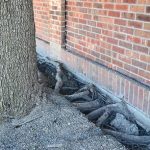Weathering Of Rock Mass
‘Weathering is the process of alteration and breakdown of rock and soil materials at and near the Earth’s surface by chemical decomposition and physical disintegration’
Of particular note in this definition is that weathering is described as a process. It is not a method for describing the engineering properties of a rock mass. As such, describing the state of weathering must never be a substitute for an adequate description of the intrinsic physical/mechanical properties of a rock mass using the standard descriptors set out in this guideline (e.g. strength, defects, fabric, rock type). If the degree of weathering cannot be determined, for example because the unweathered version of a particular rock type has not been seen, it is best left out of the description.
It is recognised that the state of weathering of all rock masses (and ‘soil’ masses such as coarse alluvial and pyroclastic deposits) cannot be accurately described using a common weathering scale, and this should not be attempted if ambiguity results. What is important is to fully describe the effects of weathering.
There are many methods and scales for describing the weathering of rock masses.
This post is aimed at the overall description of a rock mass, a description of weathering which addresses both changes in the rock material and in the discontinuities is preferred.
If there remains a significant difference in weathering of the defects as compared to the weathering category for the overall rock mass, then this should be pointed out as part of the description (e.g. 200 mm thick soil seam within a slightly weathered rock mass).
Types Of Rock Weathering
The effects of weathering are to be described using the standard soil and rock description terminology in terms of:
§ Colour and colour changes;
§ Strength and reduction of strength;
§ Condition of discontinuities and their infill; and
§ Weathering products.
While primarily applicable to rock masses it is intended that the effects of weathering on other geological materials such as alluvial and volcanic deposits also be routinely included in descriptions.
Based on the descriptions of weathering effects and products, the rock mass can be classified according to a general weathering scale (See Table below). Other scales may be used to aid classification and communication, particularly if the weathering environment is uncommon (e.g. desert/alpine).
In very general terms the boundary between a rock mass being more ‘rock like’ than ‘soil like’ is the boundary between moderately weathered and highly weathered.
Different types of weathering of rock mass is given in the following table.



![How To Determine Weight Volume Relationship Of Soil? [Step By Step]](https://civilengineering.softecks.in/wp-content/uploads/2022/05/4-8-150x150.jpg)